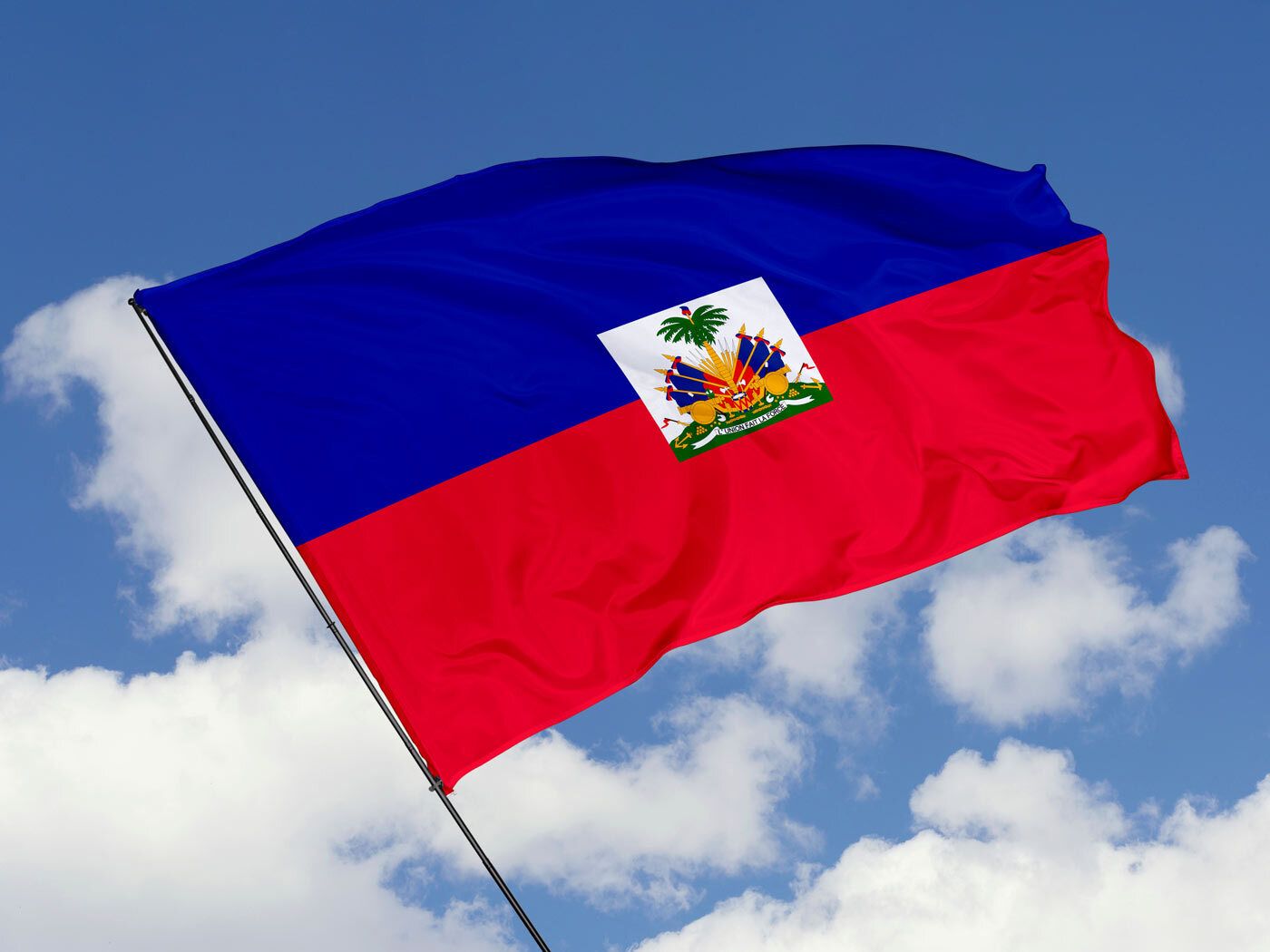- Calendar
- Calendar 2025
- May
- Haitian Flag Day
Haitian Flag Day
The Haitian Flag Day is celebrated annually on May 18 to commemorate the adoption of the flag in 1803.
This landmark day honors the creation of the Haitian flag during the Haitian Revolution which symbolizes freedom, resistance, and the birth of an independent nation.
It is a public holiday in Haiti and also observed across the globe by Haitian communities.
The Origin of Haitian Flag Day
Haitian Flag Day commemorates the creation of the country’s national flag on May 18, 1803, during the historic Congress of Arcahaie.
This pivotal moment in Haiti’s fight for independence was led by Jean-Jacques Dessalines, one of the revolution's key leaders.
In a symbolic act of defiance, Dessalines tore the white stripe from the French tricolor flag, representing the rejection of colonial rule and the unity of blacks and mulattoes in their struggle for freedom.
The two remaining stripes, blue and red, were sewn together by Catherine Flon, a heroic figure in Haitian history.
This new flag carried the powerful motto “Liberty or Death”, embodying the determination and sacrifice of those fighting for independence.
The flag’s creation marked a turning point in Haiti’s revolution, serving as a symbol of resistance and solidarity.
The Story of the Flag of Haiti
The flag of Haiti, known as the drapo Ayiti, is a striking bicolor design with two horizontal bands: blue on the top and red on the bottom. At its center, a white rectangular panel features Haiti’s coat of arms, a rich symbol of the nation's independence and unity.
The coat of arms includes:
- A green hill, representing the land of Haiti.
- A royal palm, symbolizing independence, crowned by the Cap of Liberty.
- A trophy of weapons, showcasing strength and readiness to defend freedom.
- The national motto “L'Union fait la Force” (Unity Makes Strength), displayed on a white ribbon beneath the emblem.
The current design of the flag dates back to 1806, introduced by President Alexandre Pétion following Haiti's revolution.
It was officially readopted on February 25, 2012, under Article 3 of the Haitian Constitution.
L'emblême de la Nation Haïtienne est le Drapeau qui répond à la description suivante:
- Deux (2) bandes d'étoffe d'égales dimensions: l'une bleue en haut, l'autre rouge en bas, placées horizontalement;
- Au centre, sur un carré d'étoffe blanche, sont disposées les Armes de la République;
- Les Armes de la République sont : Le Palmiste surmonté du Bonnet de la Liberté et, ombrageant des ses Palmes, un Trophée d'Armes avec la Légende: L'Union fait la Force.
While the constitution specifies a square white field for the coat of arms, in practice, this is often rendered as a rectangle with an 11:9 ratio. Additionally, Haiti's civil flag, which omits the coat of arms, is sometimes used in unofficial contexts.
The Haitian flag is unique in its incorporation of the flag itself within its design, a characteristic shared with only a few other national flags worldwide. It also features a depiction of a gun, joining a small group of UN member states, including Mozambique and Guatemala, whose flags incorporate such imagery.
The Journey of Haiti
Haiti’s journey is a powerful story of resilience, freedom, and identity. As the first independent Black republic in the world, Haiti’s history reflects the enduring spirit of its people.
Colonial Struggles
In the late 15th century, Christopher Columbus landed on the island of Hispaniola, where Haiti is located.
The Spanish initially claimed the land, but by the 17th century, the French took control of the western part, establishing the colony of Saint-Domingue.
Fueled by enslaved African labor, the colony became the world's leading producer of sugar, coffee, and indigo. However, the brutal exploitation of enslaved workers created a foundation of unrest.
The Fight for Independence
In 1791, a massive slave revolt began, marking the start of the Haitian Revolution.
Inspired by the ideals of freedom and equality from the French and American revolutions, leaders like Toussaint Louverture, Jean-Jacques Dessalines, and Henri Christophe led enslaved people to fight for their freedom.
After years of conflict, Haiti declared independence on January 1, 1804, becoming the first nation to abolish slavery and establish a government led by formerly enslaved people.
Post-Independence Challenges
Haiti's victory came at a cost. The country faced isolation from global powers, including economic blockades and refusal of recognition.
In 1825, France demanded reparations for lost property, plunging Haiti into debt that took over a century to repay.
Political instability, foreign interventions, and natural disasters further complicated Haiti’s development.
Modern Haiti
Despite ongoing challenges, Haiti remains a symbol of resistance and cultural pride.
Its rich traditions, such as vibrant art, music, and spirituality rooted in Vodou, celebrate the legacy of its ancestors.
The Haitian diaspora also plays a vital role in preserving and promoting Haiti's unique identity worldwide.
Today, the nation continues to rebuild and redefine itself, striving toward a brighter future.
Haiti’s journey is a testament to the strength and determination of its people, standing as a beacon of hope and a reminder of the power of unity in the fight for justice.
Observance of Haitian Flag Day
In Haiti, the National Palace grounds serve as the focal point of festivities, where citizens come together to honor the flag and the legacy it represents.
These celebrations often include parades, cultural performances, and speeches reflecting the nation’s pride and heritage.
For Haitians living abroad, the day is equally significant. Communities in countries like the United States organize events to honor their heritage and celebrate Haitian culture.
A notable example is the Haitian Day Parade in New York City, held annually on the last Sunday of May along Toussaint Louverture Boulevard (Nostrand Avenue).
Initiated in 2002 by the Haitian-American Carnival Association, the parade features vibrant displays of Haitian music, dance, and art.
It culminates in a cultural festival showcasing traditional cuisine and the contributions of Haitian-Americans.
Other cities also host observances during Haitian Heritage Month in May.
Boston, for instance, highlights the struggles and history of the Haitian people, while cities in Florida, including Miami, Tampa, Delray Beach, Fort Lauderdale, and Fort Myers, hold events that promote Haitian culture.
Miami’s MOCA Plaza celebrations stand out, featuring notable Haitian-American personalities from various fields, adding to the day’s significance.
Despite the global recognition and festivities, Haitian Flag Day was notably impacted in 2020 due to the COVID-19 pandemic.
Traditional celebrations were canceled worldwide, with many communities opting for scaled-back observances like flag-raising ceremonies, such as the one held in Norwich, Connecticut.
These adjustments underscored the resilience of Haitian communities in preserving their cultural identity even amid challenging circumstances.
Haitian Flag Day remains a vibrant expression of national pride and a testament to the enduring spirit of Haiti and its people.

Other Celebrations
-
May 01 ThuHaitian Heritage Month
-
May 01 Thu
-
May 01 Thu
-
May 15 Thu
-
Jun 14 Sat
-
Oct 18 Sat

Haitian Flag Day - Next years
Monday, 18 May 2026
Tuesday, 18 May 2027
Thursday, 18 May 2028











